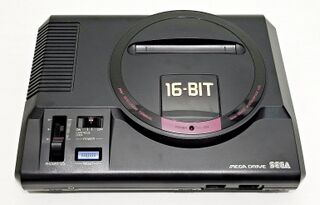Andlabs/Sega Mega Drive
From Sega Retro
- This rewrite is under active development and will replace the original page once complete.

|
| Andlabs/Sega Mega Drive |
|---|
| Manufacturer: Sega |
| Variants: Mega Drive 2, Genesis 3, Sega Mega Jet, Sega Nomad, Sega Teradrive |
| Add-ons: Sega CD, 32X, Power Base Converter, Super Magic Drive |
The Sega Mega Drive, called Sega Genesis in the United States due to trademark issues, is a video game console developed by Sega in 1988 in an attempt to take back its losses in the home gaming market from Nintendo by creating a home console to provide a closer arcade experience at home. Arcade hardware manufacturers had been creating games with more complex visuals and soundscapes than the Nintendo Entertainment System could provide, and Sega saw an opportunity for success — using scaled down versions of commonplace arcade components that would fit more easily in a consumer's budget.
It was first released in Japan on October 29, 1988 with two launch titles, Space Harrier II and Super Thunder Blade, and retailing at ¥21,000. International releases would come over the next few years. The early game library and marketing campaigns focused on the arcade-at-home stance, and the Mega Drive found itself following the trends of arcade games at the time — shoot-'em-ups.
Consumers quickly became weary of the constant stream of arcade ports, and over time, game developers started putting different games on the Mega Drive — from RPGs like Sword of Vermilion and Shining in the Darkness to strategy games like Super Daisenryaku (the first third-party game in Japan) and Herzog Zwei (generally referred to as the first real-time strategy) to platformers like Castle of Illusion Starring Mickey Mouse and so on. Electronic Arts's support as a third party developer furthered this distancing, as EA's catalog, stemming from their history as computer game publishers, was much more diverse, primarily focusing on sports games. The release of Sonic the Hedgehog in 1991 finished this distancing, as developers scrambled to compete with Sega's new success.
Sega also played the console add-on game with the Sega Mega CD, which impressed gamers in Japan with a rich variety of games, however overseas, marketing focused on "full motion video" games that continuously failed to impress.
Nevertheless, games from all genres continued rolling in through to 1995. The Sega Saturn was already out in Japan and newcomer Sony was ready to tout its new PlayStation as the future. The success of the Super Nintendo Entertainment System had started to increasingly steal Sega's thunder from 1991. Third-party support for the Mega Drive disintegrated as the newer consoles and the improved capabilities of the Mega Drive's competitors wooed developers away. Finally, in a combination of poor communication between Sega of America and Sega of Japan and the desire to keep the Mega Drive afloat, Sega of America released the Sega 32X, an add-on which added its own additional capabilities to the Mega Drive, such as a larger color gamut. The 32X was released too late, had manufacturing errors at launch, and was too expensive to impress, and promptly fell flat on its face.
The Mega Drive died in Japan in 1995, with Sega releasing its last first-party game in Decenber and Compile releasing the last third-party game the following year. However, Sega contracted Majesco to continue manufacturing Mega Drives in the US and Europe through 1998, and the few third party developers and first party studios that stayed on board produced games like Vectorman 2 and Sonic 3D: Flickies' Island and many compilations. In an ironic twist of fate, a straight port of Frogger would be the last officially released Mega Drive game.